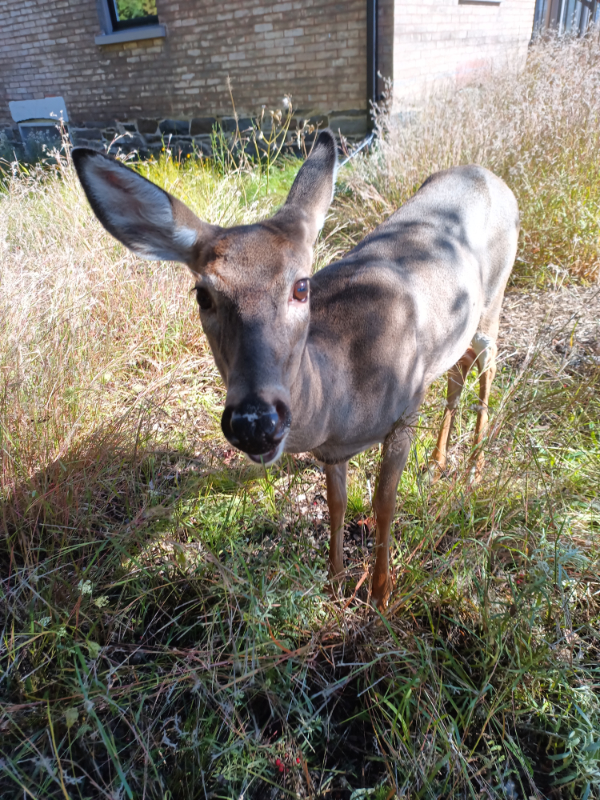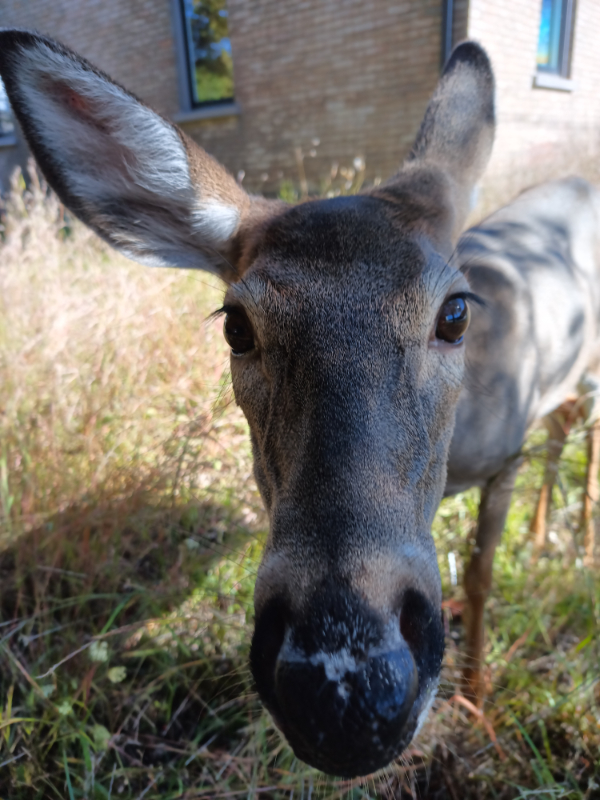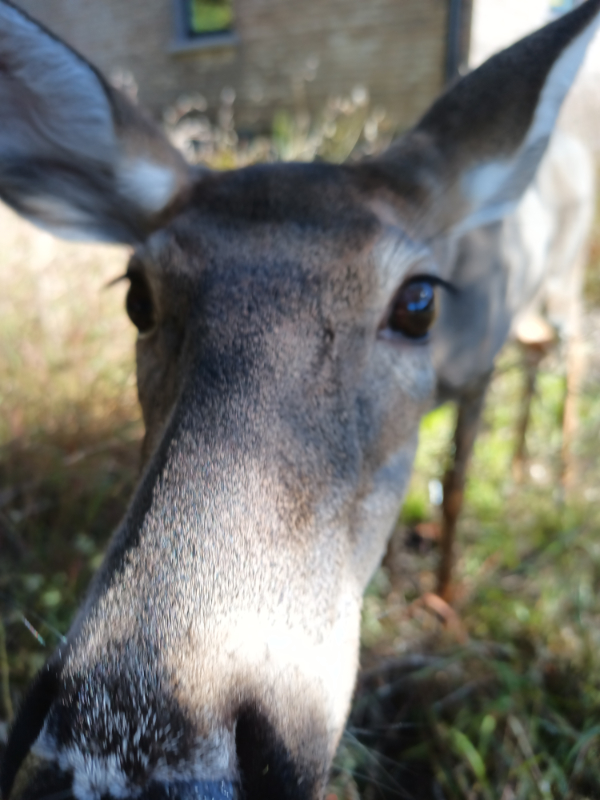Haliburton Deer: Lessons and Hope From the Garden at Lucas House
Haliburton deer and gardens: It seems like they’ll never get along. But maybe there’s a way embrace our hungry friends.
It’s no secret that Haliburton Village has a lot of deer. Despite the deer feeding bylaw (or maybe because it’s too soon to tell), there are plenty of the animals dining or bedding down in town. A friend saw about eight on her way into work the other day – and that’s just between the Gardens of Haliburton residence and Lucas House, by the post office. That’s a lot in a small space.
This article isn’t about the legality or ethics of feeding deer or whether we have an over-population. It’s about how we can live with deer and still have a flourishing native plant garden.
A few weeks ago I found an excellent article by Nancy Lawson called Deer Eat This Garden (and it Flourishes). I encourage you to read it.
This article takes a lot of information from Lawson’s piece and contextualizes it for Lucas House, my test garden in Haliburton Village, and the Highlands as a whole. That includes the landscape at your home or cottage.
First, the ethics and philosophy of living with deer

You already know I want to coexist with deer. That’s consistent with my ethics as a native plant supporter. The key to human flourishing is to allow nature to flourish too.
The time has passed when we can treat the rest of nature as there to serve us…and when it stops serving us, wipe it out. We know nature is a complex web of relationships, so when we pull at this web’s strands, bad things happen.
Native plants are about gardening in harmony with nature. So that means we also need to plant in harmony with deer.
You can of course argue that the population of deer is out of whack, particularly in our towns. You can argue that there’s a lack of natural predators, or that humans have been feeding them and thereby taming them, or that indeed our juicy gardens are inviting them to chow down. All those things are in part true.
The fact is, deer are here, so we can either fight them or we can learn to live with them. I prefer the latter because I prefer coexistence over conflict. Life’s too short to wage war on an animal.
Haliburton deer and the garden at Lucas House
That’s not to say deer don’t drive me insane. The garden at Lucas House isn’t as good as it could be. That’s partly due some mistakes I made, but a lot of it is down to deer eating it.
At the same time, Lucas House is better than it could have been if I had not thought somehow about how I’m going to live with deer.

So here’s the scoop:
The garden is browsed by deer every day. This summer, for example, there were a mother and fawn there frequently, sometimes spending extended periods resting in the garden. Sometimes the mother left the fawn there while she browsed elsewhere.
There are several plants they have browsed on and whose growth they affected:
- Lanceleaf Coreopsis – ate the flowers and half the stems
- Black-eyed Susan – ate the flowers
- Pale Purple Coneflower – ate the flowers and stems
- Some shrubs – browsed on the leaves and stunted them
However, there are several plants (and I give myself a pat on the back for using them) that they did not touch:
- Little Bluestem – deer generally don’t like grasses, and this is one heck of a grass
- Slender Mountain Mint – deer don’t like plants with flavours
- Pearly Everlasting – they don’t touch it and I don’t know why
- Some species of aster – they have left some, but they have eaten others. Go figure.
- Swamp Milkweed – deer don’t like Milkweeds (indeed, most animals and insects don’t – it’s their superpower)
- Sedges – deer don’t like sedges – too grass-like
- Plains Coreopsis (an annual) – I don’t think they touched this, but there are so many plants that maybe they have and the buffet still looks full
The bottom line is this: while Lucas House is a success in many ways, it’s not as good as it could be. It doesn’t have enough flowers because the deer have been dead-heading them before they got a chance to bloom. Perhaps more important to me, there are areas that have too many weeds because there aren’t enough intentional plants there to outcompete the weeds.
The good news is, if I can solve the problem at Lucas House, I can solve the problem anywhere. While deer can (and likely will) strike your landscape, I don’t think anywhere in the county has the kind of pressure that Lucas House does.
How to change deer from foe to (almost) friend in your garden
Here are some ideas I’ve tweaked from Lawson’s article. Let’s see how we can apply them to our Haliburton landscapes.
Plants aren’t as weak as we sometimes think

Plants can benefit from being gnawed on. After all, they get nibbled in nature and they’re doing OK. (You could argue that too much nibbling when the nibblers are out of balance can harm an ecosystem, so this isn’t a slam-dunk.)
Plants can respond by producing more foliage and putting down more roots when browsed upon. This has happened at Lucas House: I have a patch of Lanceleaf Coreopsis that are continually browsed, but the plants have spread and their foliage has become more dense. I think this is good news for next year, because a stronger, larger, more resilient patch of plants will produce more flowers. Indeed, it might produce so many flowers that a few that get eaten won’t be noticed.
Plants can also release chemical alarms to deter further browsing, increase defensive compounds in their foliage, invest more energy in root systems, sprout more flower buds, thicken their leaves, or grow more thorns.
I do think, however, that too much browsing on new plants should be watched. It’s why I use a natural deer repellent, such as Bobbex, on new plantings.
Sidebar: I think the time when a plant is most vulnerable is when it comes fresh from the nursery. There’s your new plant, all plumped up with juicy leaves to make it look good – it’s a veritable salad in a pot. I discovered this when I ordered hundreds of Wild Strawberry plants for Lucas House. I didn’t have my green cage then, and the first night deer nibbled them (almost) to death. The good news is, they came back. The even better news is, a year after they were planted, they are getting established and I don’t notice them being eaten anymore.
Plants are stronger in communities
One of the things I bang on about here is to plant in communities. Instead of seeing plants as individuals, see them as a community with other plants. After all, that’s how nature is – you don’t get monocultures, you get plants living with all sorts of other plants.

This concept is known as “associational resistance” or “associational defense”. It involves mixing plants with different levels of palatability to deer. In nature, vulnerable plants often grow among those with better defenses.
Mimicking nature in this way makes it harder for deer to find the plants they like to eat from among the less palatable species.
For instance:
- Planting grasses among flowers can make it harder for deer to selectively browse
- Mixing chemically defended plants (like those in the mint family) with tastier species
- Creating diverse meadows where deer have to search for preferred plants rather than having easy access to a monoculture
I did plant Lucas House in communities (as I do with all the landscapes I create). However, I saw the community as a whole, not as mini-communities within it. If I were doing it again, I would have each group of plants smaller, so each would be closer to its friends. That does to some extent change the design, from less traditional and formal to more meadow-like, but it is more true to nature. And it doesn’t have to be like a random meadow: it can be designed, by planting clumps and drifts.
I will do things like this:
- Instead of planting individual species in isolation, I will group different plants together. For example Mountain Mint (deer go urgh) with Black-eyed Susan (deer go yum).
- I’ll aim for a ratio of about 50% deer-resistant plants to 50% more vulnerable species.
- I will use taller plants like grasses or ferns to shield lower-growing species.
Another quick sidebar: As well as planting in communities, I plant densely. That means lots of plants. The benefit is, deer can have a snack and it doesn’t ruin dinner. Traditionally, with each plant seen as a separate specimen, we’ve viewed each as special and are horrified when, for example, “my hosta got eaten”. Instead, if one plant gets eaten and five others are fine, it’s no biggie.
Hire bodyguards for your plants
This is a different take on the communities thing. But it’s more deliberate.
Use deer-resistant plants to protect less-resistant plants. The idea is that deer won’t engage with the plants they don’t like in order to reach the plants they do. These bodyguards can be planted close or even intermingled with the more vulnerable plants. For example:
- Incorporate grasses like bluestems, Purple Lovegrass, or Wwitchgrass throughout the garden.
- Plant ferns such as Ostrich Ferns or Royal Ferns in shaded areas.
- Use sedges (Carex species) as groundcover in (mainly) shaded areas.
- Integrate mint family plants like Mountain Mint, or Wild Bergamot.
I used bodyguards at Lucas House – Little Bluestem and Mountain Mint – but I didn’t do it strategically enough. There are still places where deer can reach vulnerable plants. An example is the Lanceleaf Coreopsis I mentioned earlier: it’s by the sidewalk,in reach of the deer’s daily stroll.
Embrace weeds

This one takes a while to get your head around. We natural gardeners are OK with weeds popping up here and there… as long as they’re not invasive.
We call these plants we didn’t plant “volunteers” – and those free helpers can be… quite helpful. That’s because many of them are great deer food, so they take the pressure off your precious plants.
It’s important, of course, to learn what’s good and what’s bad. You don’t want aggressive weeds taking over, and maybe you don’t want too many non-natives which are often the first to pop up on a newly planted site.
But if you recognize a plant that deer like which is not doing any harm, let it be.
I’ve done that at Lucas House. I have quite a few plants I didn’t plant popping up happily. I let them be because they’re mostly native. If the deer eat then, that’s fine. If they don’t, then I have a free plant.
Leave snacks by the roadside
Once you’ve had your garden for a while, you get an idea of where deer go. At Lucas House, for example, deer go from the parking lot through the garden by the post office.
Once you know where they go, plant snacks for them, so they eat those plants instead of the ones you love.
I think I will try this, as long as they don’t eat me out of house and home.
Let plants be plants, let gardens be gardens, let deer be deer
It’s easy to panic or become despondent when a newly-planted garden becomes dinner for deer. We reach for the nine-foot fence, we spray with Bobbex (which I have used and is helpful, but you have to keep on top of it), or we give up.
But gardens take a few years to establish. Browsed plants get stronger. New plants move in. Eventually, the landscape falls into equilibrium with the deer.
That, at least, is the theory. I believe evidence will prove it true. I just hope I have the patience to apply these techniques and wait for nature to do its thing.
I’ll keep you posted.
